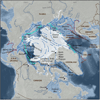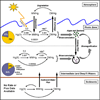Mercury in Arctic marine ecosystems: sources, pathways and exposure
- PMID: 23102902
- PMCID: PMC4142812
- DOI: 10.1016/j.envres.2012.08.012
Mercury in Arctic marine ecosystems: sources, pathways and exposure
Abstract
Mercury in the Arctic is an important environmental and human health issue. The reliance of Northern Peoples on traditional foods, such as marine mammals, for subsistence means that they are particularly at risk from mercury exposure. The cycling of mercury in Arctic marine systems is reviewed here, with emphasis placed on the key sources, pathways and processes which regulate mercury levels in marine food webs and ultimately the exposure of human populations to this contaminant. While many knowledge gaps exist limiting our ability to make strong conclusions, it appears that the long-range transport of mercury from Asian emissions is an important source of atmospheric Hg to the Arctic and that mercury methylation resulting in monomethylmercury production (an organic form of mercury which is both toxic and bioaccumulated) in Arctic marine waters is the principal source of mercury incorporated into food webs. Mercury concentrations in biological organisms have increased since the onset of the industrial age and are controlled by a combination of abiotic factors (e.g., monomethylmercury supply), food web dynamics and structure, and animal behavior (e.g., habitat selection and feeding behavior). Finally, although some Northern Peoples have high mercury concentrations of mercury in their blood and hair, harvesting and consuming traditional foods have many nutritional, social, cultural and physical health benefits which must be considered in risk management and communication.
Copyright © 2012 Elsevier Inc. All rights reserved.
Figures











References
-
- AMAP. Mercury in the Arctic. Oslo: Arctic Monitoring and Assessment Programme (AMAP); 2011. AMAP Assessment 2011.
-
- Andersson ME, Gårdfeldt K, Jutterström S. Air–sea exchange of volatile mercury in the North Atlantic Ocean. Mar. Chem. 2011;125:1–7.
-
- Andersson ME, Sommar J, Gardfelt K, Lindqvist O. Enhanced concentrations of dissolved gaseous mercury in the surface waters of the Arctic Ocean. Mar. Chem. 2008;110:190–194.
-
- Andersson ME, Gårdfeldt K, Wängberg I, Sprovieri F, Pirrone N, Lindqvist O. Seasonal and daily variation of mercury evasion at coastal and off shore sites from the Mediterranean Sea. Mar. Chem. 2007;104:214–226.
-
- Ariya P, Dastoor A, Amyot M, Schroeder W, Barrie L, Anlauf K, Raofie F, Ryzhkov A, Davignon D, Lalonde J, Steffen A. The Arctic: A sink for mercury. Tellus B. 2004;56:397–403.
MeSH terms
Substances
Grants and funding
LinkOut - more resources
Full Text Sources
Medical

